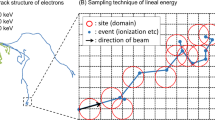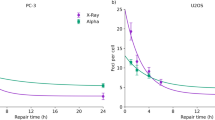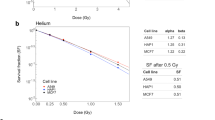Abstract
THE mechanisms by which mammalian cells are killed by ionising radiation have not been explained at the molecular level and radiations with a high linear energy transfer (LET) can provide an important tool for investing these mechanisms. High-LET radiations, such as neutrons, π-mesons and low-energy heavy ions are known to kill bacteria1,2, yeast3,4, and mammalian cells in vitro5–9 more efficiently per unit dose than radiations with diffuse patterns of ionization, or low-LETs, such as γ or X rays. Other radiobiological phenomena associated with high-LET radiations are a reduced effect of chemical modifiers, for example, oxygen10, on cellular radiation sensitivity and reduction or loss of cellular ability to recover from radiation damage between split radiation doses5,8. Because of these and other attributes, including the favourable depth–dose distribution of heavy ions and π-mesons, high-LET radiations are being actively considered for use in cancer radiation therapy11,12, and a thorough understanding of their biological effects is necessary for them to be used to advantage clinically. We report here that, over an LET range of 1–1953 KeV µm−1, there is an excellent correlation between the efficiency of exponential (single-hit) cell killing and the induction of non-rejoining DNA strand breaks, as measured on alkaline sucrose gradients. This correlation implies that non-rejoined breaks are a cause of cell death.
This is a preview of subscription content, access via your institution
Access options
Subscribe to this journal
Receive 51 print issues and online access
$199.00 per year
only $3.90 per issue
Buy this article
- Purchase on Springer Link
- Instant access to full article PDF
Prices may be subject to local taxes which are calculated during checkout
Similar content being viewed by others
References
Munson, R. J., Neary, G. J., Bridges, B. A. & Preston, R. J. Int. J. radiat. Biol. 13, 205–224 (1967).
Powers, E. L., Lyman, J. T. & Tobias, C. A. Int. J. radiat. Biol. 14, 313–330 (1968).
Sayeg, J. A., Birge, A. C., Beam, C. A. & Tobias, C. A. Radiat. Res. 10, 449–461 (1959).
Manney, T. R., Brustad, T. & Tobias, C. A. Radiat. Res. 18, 374–388 (1963).
Barendsen, G. W. Int. J. radiat. Biol. 8, 453–466 (1964).
Deering, R. A. & Rice, R., Jr Radiat. Res. 17, 774–786 (1962).
Skarsgard, L. D., Kihlman, B. A., Parker, L., Pujara, C. M. & Richardson, S. Radiat. Res. Suppl. 7, 208–221 (1967).
Todd, P. Radiat. Res. Suppl. 7, 196–207 (1967).
Raju, M. R., Gnanapurani, M. & Richman, C. Br. J. Radiol. 45, 178–181 (1972).
Barendsen, G. W. in The Initial Effects of Ionizing Radiations on Cells (ed. Harris, R. J. C.) 183–194 (Academic, New York, 1961).
Lawrence, J. & Tobias, C. in Mod. Trends Radiother. 1, 260–276 (1967).
Tobias, C. A. & Todd, P. in National Cancer Institute Monograph 24, Conference on Radiobiology and Radiotherapy, 1–15 (US Department of Health, Education and Welfare, 1967).
Sinclair, W. K. Cancer Res. 27, 297–308 (1967).
Mortimer, R., Brustad, T. & Cormack, D. V. Radiat. Res. 26, 465–482 (1965).
Puck, T. Prog. Biophys. biophys. Chem. 10, 237–258 (1960).
Barendsen, G. W., Walter, H. M. D., Fowler, J. F. & Bewley, D. K. Radiat. Res. 18, 106–119 (1963).
Chadwick, K. H. & Leenhouts, H. P. Phys. med. Biol. 18, 78–87 (1973).
Todd, P. thesis, Univ. California, Berkeley (1964).
Todd, P. W. Radiat. Res. 61, 288–297 (1975).
Kapp, D. S. & Smith, K. C. J. Bact. 103, 49–54 (1970).
Painter, R. B., Young, B. R. & Burki, H. J. Proc. natn. Acad. Sci. USA 71, 4836–4838 (1974).
Cleaver, J. E., Thomas, G. H. & Burki, H. G. Science 177, 996–998 (1972).
Burki, H. J., Roots, R., Feinendegen, L. E. & Bond, V. P. Int. J. radiat. Biol. 24, 363–375 (1973).
Howard-Flanders, P. Adv. Biol. med. Phys. 6, 553–603 (1958).
Christensen, R. C., Tobias, C. A. & Taylor, W. D. Int. J. radiat. Biol. 22, 457–477 (1972).
Cole, A., Shonka, F., Corry, P. & Cooper, W. G. in Molecular Mechanisms for Repair of DNA (eds Hanawalt, P. C. & Setlow, R. B.) 665–676 (Plenum, New York, 1975).
Ehmann, U. K. & Lett, J. T. Radiat. Res. 54, 152–162 (1973).
Cleaver, J. E. in Meth. Cancer Res. 11, 123–165 (Academic, New York, 1975).
Dugle, D. L., Gillespie, C. J. & Chapman, J. D. Proc. natn. Acad. Sci. USA 73, 809–812 (1976).
Author information
Authors and Affiliations
Rights and permissions
About this article
Cite this article
RITTER, M., CLEAVER, J. & TOBIAS, C. High-LET radiations induce a large proportion of non-rejoining DNA breaks. Nature 266, 653–655 (1977). https://doi.org/10.1038/266653a0
Received:
Accepted:
Issue Date:
DOI: https://doi.org/10.1038/266653a0
This article is cited by
-
Radium-223 mechanism of action: implications for use in treatment combinations
Nature Reviews Urology (2019)
-
Practical recommendations for radium-223 treatment of metastatic castration-resistant prostate cancer
European Journal of Nuclear Medicine and Molecular Imaging (2017)
-
Radiopharmaceuticals for metastatic bone pain palliation: available options in the clinical domain and their comparisons
Clinical & Experimental Metastasis (2017)
-
Diallyl disulfide attenuated carbon ion irradiation-induced apoptosis in mouse testis through changing the ratio of Tap73/ΔNp73 via mitochondrial pathway
Scientific Reports (2015)
-
Dosimetric study of radium-223 chloride and 153Sm-EDTMP for treatment of bone metastases using MCNPX code and available experimental data
Journal of Radioanalytical and Nuclear Chemistry (2014)
Comments
By submitting a comment you agree to abide by our Terms and Community Guidelines. If you find something abusive or that does not comply with our terms or guidelines please flag it as inappropriate.



